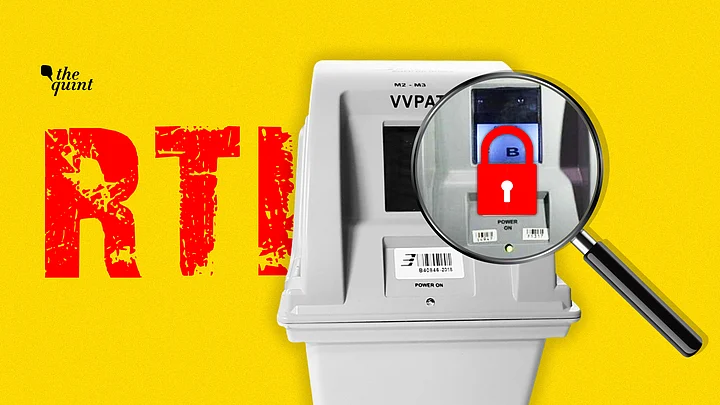The current state of India’s Election Commission (EC) raises doubts about its transparency and fairness, especially when we find that it is misleading the public in its RTI replies.
The EC was constituted in 1950 to conduct free and fair elections, and was established as an autonomous body solely so that it can work independently. Is that what it’s doing?
The Quint filed an RTI seeking information and documents on the VVPAT count data during the Lok Sabha elections 2019. In reply, the EC refused to share the documents on the grounds that the VVPAT data is not available with the Commission (which means, at the EC headquarters in Delhi).
Below is the RTI reply from the EC.
“Polling Station wise data of Lok Sabha Election, 2019 is not available with the Commission. It may be available with CEOs of all States/UTs. You may obtain information from the office of CEOs of the States/UTs by submitting application under RTI Act, 2005 separately. Your application can not be transferred to them as more than one PIOs are involved u/s 6 (3) of RTI Act, 2005.”EC’s RTI Reply
Here’s How the EC Is Misleading Citizens
The above RTI reply is misleading on two grounds.
- Circulars issued by the EC themselves say that all Chief Election Officers (CEOs) are to submit their VVPAT data to the Commission within 7 days from counting day. So why is the data ‘not available’ with them?
- The Chief Information Commission (CIC) order says that even if multiple PIOs are needed to share the information, it is the responsibility of the PIO in possession of the RTI to transfer it to rest of the PIOs. So why did they claim they cannot transfer the request to more than one PIO?
State CEOs to Share VVPAT Data With Commission: EC’s Circular
The Supreme Court on 8 April 2019 ordered the EC to count 5 random VVPATs in each Assembly segment/constituency. Based on that SC order, the EC issued two circulars dated 15 April and 21 May in connection with the VVPAT slip count.
EC’s circular issued on 15 April said “The CEO shall compile the reports for the entire State/UT and submit a consolidated summarised report to the Commission within 7 days from the end of counting process”.
Along with the circular, the EC attached a form which specified details like ‘name of the Assembly segment, name of the candidates, number of EVM votes, number of VVPAT count etc’. It’s these details that the government is refusing to share.
CEOs to Submit VVPAT Slip Verification & VVPAT Slip Count: EC Circular
The circular issued on 21 May said that the CEOs of all States/UTs will not only submit a detailed report on “VVPAT slip verification’ (VVPAT slips verified against the EVM count), but will also submit the VVPAT slip count to the Commission” immediately.
PIO Can Transfer RTI To Multiple PIOs
Now if, for a moment, we believe that the EC doesn’t have the VVPAT count – despite the fact that all the circulars clearly indicate that they are required to have received it through CEOs – then why didn’t the EC at least transfer The Quint’s RTI to the PIOs of other States/UTs as it is supposed to?
While giving a judgment in connection with the RTI complaint on 16 June 2011, Shailesh Gandhi, the then-Central Information Commissioner, said,
“If the records and operations were computerised, transferring an RTI application to even 50 or 100 public authorities could be done with a click of mouse or by email. If public authorities do not meet commitments implied in the RTI Act, the citizen cannot be denied his fundamental right.”
PIOs Can Be Penalised For Misleading
The Quint filed an appeal to this RTI reply and will continue to follow it up. An applicant can file a complaint against the PIO for refusing access to information under section 20 (1) of the RTI Act, which says:
If the PIO “has not furnished information within the time specified or malafidely denied the request for information or knowingly given incorrect, incomplete or misleading information or destroyed information which was the subject of the request or obstructed in any manner in furnishing the information, it shall impose a penalty of two hundred and fifty rupees each day till application is received or information is furnished”, however, the penalty will not exceed Rs 25,000.
The section also specifies that the PIO will be given reasonable opportunity to be heard by the CIC before any penalty is imposed on him or her.
(At The Quint, we question everything. Play an active role in shaping our journalism by becoming a member today.)
